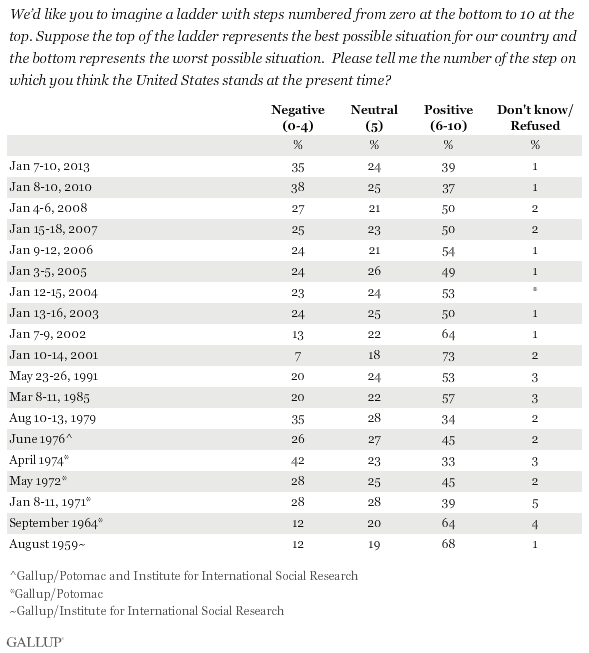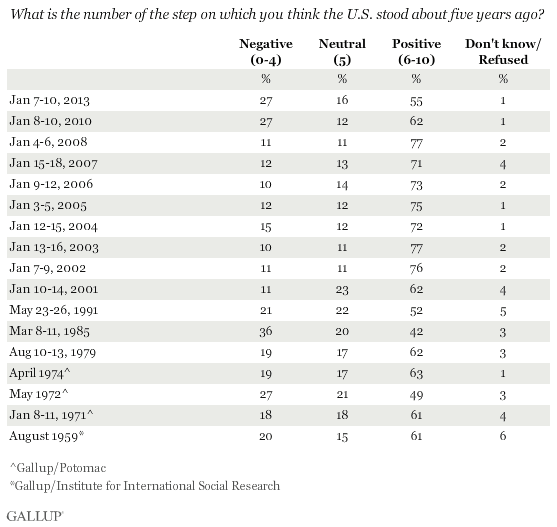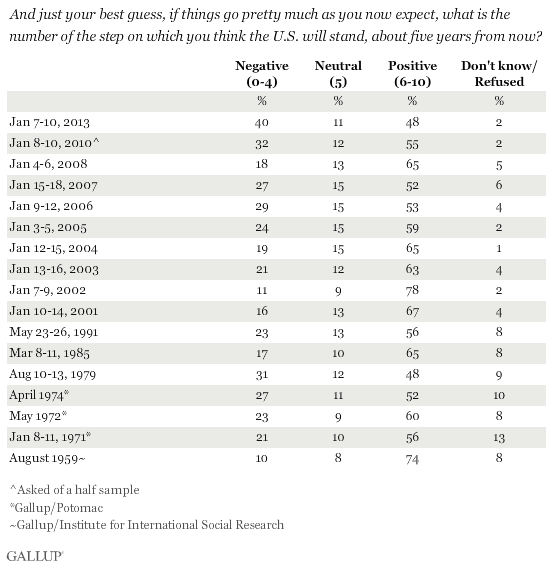PRINCETON, NJ -- U.S. President Barack Obama begins his second term at a time when Americans are as negative about the state of the country and its prospects going forward as they have been in more than three decades. Fewer than four in 10 Americans (39%) rate the current status of the U.S. at the positive end of a zero to 10 scale. This is about the same as in 2010, but it is fewer than have said so at any point since 1979. As they usually are, Americans are more upbeat in their predictions of where the U.S. will be in five years (48% positive), but this is also lower than at any time since 1979. Fifty-five percent of Americans say the state of the nation five years ago was positive.
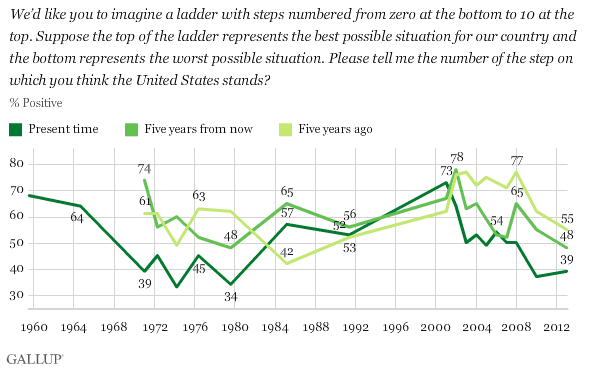
These assessments are based on a ladder scale question Gallup has used periodically since 1959. This question asks Americans to rate their feelings about the country presently, in five years, and five years ago using a zero to 10 scale, where zero equals the worst possible situation and 10 equals the best possible situation.
This latest assessment was included in Gallup's Mood of the Nation survey, conducted Jan. 7-10, 2013. Full results appear on page 2.
The 39% of Americans who give a six to 10 rating when asked to evaluate the nation's current status is similar to the 37% who said the same three years ago. Prior to that, however, assessments were generally more positive, including a 73% six to 10 rating in January 2001 -- the highest on record. The three previous points in time when ratings were as low as or lower than the 2013 rating were in August 1979 (34%), April 1974 (33%), and January 1971 (39%). The 1979 measure came at a time when the economy was in bad shape and inflation was rampant, while the 1974 measure came in the midst of the Watergate scandal. When Gallup first asked the question in August 1959, 68% of Americans rated the state of the nation in the six to 10 range.
These ratings of current conditions coincide with Americans' assessment of satisfaction with the way things are going in the U.S., which is at 25% in the same poll and below the historical average satisfaction rating.
Future, Past Ratings Also Historically Negative
The 48% who give a six to 10 ranking when asked to project the status of the U.S. five years from now is tied with the 1979 measure as the lowest in Gallup's history of asking the question. Additionally, the 40% who give a negative rating (zero to four) when asked to look ahead is lower than at any point in history. These negative ratings include 10% who say the situation of the country in five years will be zero, the worst they can imagine.
One might imagine that with the more negative current and future ratings, Americans might be more nostalgically positive about the past. Indeed, the 55% who rate the state of the nation five years ago as a six to 10 is higher than the current and future ratings. But this "looking back" measure is more negative than at any other point since May 1991. Prior to that, the measure was also low in March 1985 and May 1972.
Republicans Most Positive About Past, Democrats About Future
Americans' attitudes about the status of the U.S. are closely connected with their political views, as are many attitudinal assessments in today's highly polarized political environment. Republicans look back five years ago (when George W. Bush was still president) and view the state of the nation then as much more positive than do Democrats. On the other hand, Democrats look ahead and project a much more positive state of the nation in five years than do Republicans. In short, Republicans overwhelmingly say that the best times are behind the country, while Democrats look ahead and say the best times are ahead. The two political groups also differ in their assessment of the current state of the nation, with Democrats much more positive about the current state of the nation.
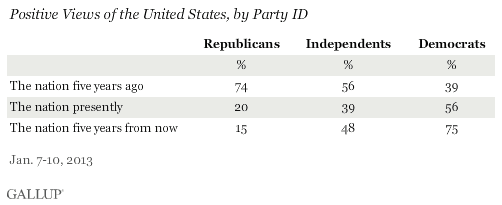
The 60-percentage-point partisan difference in optimism about the state of the nation in five years is particularly noteworthy. Democrats are overwhelmingly positive about the state the nation will find itself in in five years, while Republicans are just as markedly negative.
Implications
The challenges President Obama faces as he begins his second term in office are evident from the fact that less than four in 10 Americans rate the nation's current situation on the positive end of a zero to 10 scale and that slightly less than half project that the state of the nation will be positive in five years. Both of these assessments are among the more negative Gallup has measured since the Eisenhower administration. The bright side for the Obama administration is that the current low assessments leave much room for improvement.
Survey Methods
Results for this Gallup poll are based on telephone interviews conducted Jan. 7-10, 2013, with a random sample of 1,011 adults, aged 18 and older, living in all 50 U.S. states and the District of Columbia.
For results based on the total sample of national adults, one can say with 95% confidence that the maximum margin of sampling error is ±4 percentage points.
Interviews are conducted with respondents on landline telephones and cellular phones, with interviews conducted in Spanish for respondents who are primarily Spanish-speaking. Each sample includes a minimum quota of 500 cellphone respondents and 500 landline respondents per 1,000 national adults, with additional minimum quotas among landline respondents by region. Landline telephone numbers are chosen at random among listed telephone numbers. Cellphone numbers are selected using random-digit-dial methods. Landline respondents are chosen at random within each household on the basis of which member had the most recent birthday.
Samples are weighted by gender, age, race, Hispanic ethnicity, education, region, adults in the household, population density, and phone status (cellphone only/landline only/both, cellphone mostly, and having an unlisted landline number). Demographic weighting targets are based on the March 2012 Current Population Survey figures for the aged 18 and older U.S. population. All reported margins of sampling error include the computed design effects for weighting.
In addition to sampling error, question wording and practical difficulties in conducting surveys can introduce error or bias into the findings of public opinion polls.
View methodology, full question results, and trend data.
For more details on Gallup's polling methodology, visit https://www.gallup.com/.
